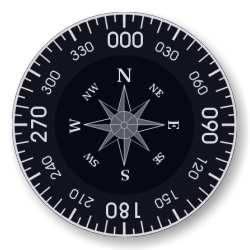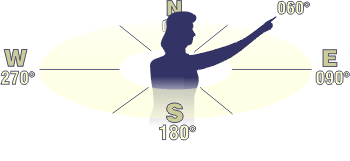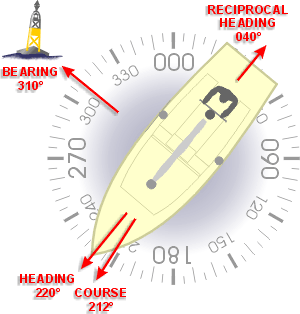 |
Section 3The Navigator's Compass |
|
| HOME MAIN TOCHELP |
 |
Section 3The Navigator's Compass |
|
| HOME MAIN TOCHELP |
3.1 |
Compass Basics |
|
The compass is the navigator's most important piece of equipment. With a reliable compass you can steer a boat on an accurate course and determine its heading. A compass requires no power. It uses the earth's magnetic field to indicate directions. The properties of magnetism are well-known and a good compass works in a predictable and reliable way. There are also electronic compasses with digital displays. These compasses are easy to use, accurate and can be connected to GPS units, radar and electronic plotters. Electronic compasses are covered in the appendix: "The Electronic Boat". Find out more about the early compass. |

|
The Compass CardThe traditional nautical compass has only one moving part: the compass card that indicates north, south, east and west. This disk-shaped card is mounted on a jeweled pivot. The card is encased in a housing with a transparent dome filled with damping fluid. Small magnets are attached to the underside of the card. Direction on the compass is indicated by the lubber's line on the housing as the compass card moves underneath it. It may appear as if the card moves inside the compass. In reality, the card and its magnets stay aligned with magnetic north as the boat turns underneath the card. |
Direction as DegreesEarly compasses indicated direction using thirty-two points: the four cardinal points of north, south, east, and west and subdivisions of these. This isn't accurate enough for modern navigation. Since the Second World War compasses have been graduated in the 360 degrees (°) of a circle. Thus 000° or 360° is north, 090° is east, 180° is south, and 270° is west. A direction of 154° is between east and south and 321° is roughly northwest. When used to describe direction, degrees are expressed as a three-digit number and the zeros are included. For example, 045°. |

|
| As a navigator you should be able to visualize the 360° circle of directions and the cardinal points. Begin by memorizing the cardinal points of 000°, 090°, 180° and 270°. |
 |
|
You should also remember that moving clockwise around the compass, or turning a boat to starboard, the degrees increase. Moving counter-clockwise or turning a boat to port, they decrease. |
Reciprocal DirectionA direction opposite another is its reciprocal. Just as south is 180° from north, reciprocal directions are 180° apart. To find the reciprocal, add 180° if the initial direction is less than 180°, or subtract 180° if it's more. For example, the reciprocal of 021° is 201° (021 + 180 = 201). The reciprocal of 333° is 153° (333 - 180 = 153). |
Course, Heading, BearingThe direction a boat travels is its course. The direction a boat's bow is pointed is its heading. A boat's course may not be the same as its heading due to the effects of current, wind or waves. Courses and headings are expressed in degrees. A bearing is the direction of an object determined by a compass. A boat could be following a course of 212° by steering a heading of 220°. A buoy abeam to starboard would be bearing the boat's heading plus 90°, or 310°. |

|
| MAIN TOC SECTION TOCPREV LESSONNEXT LESSON HELP |